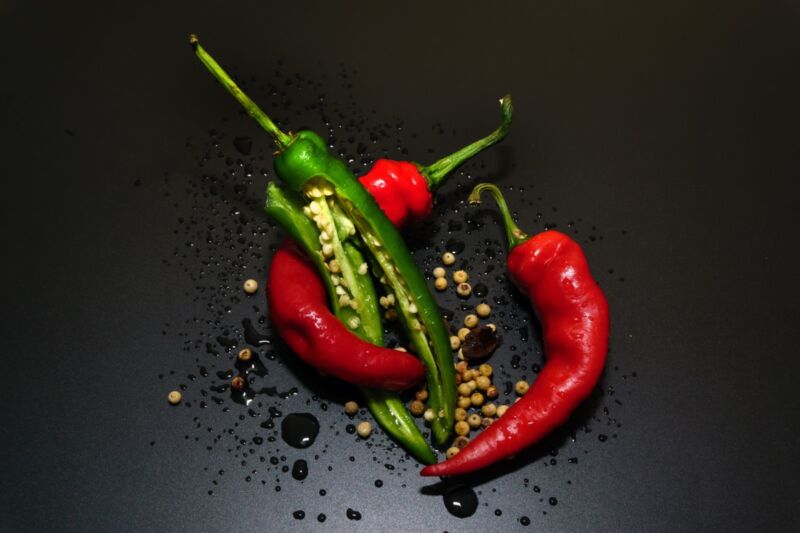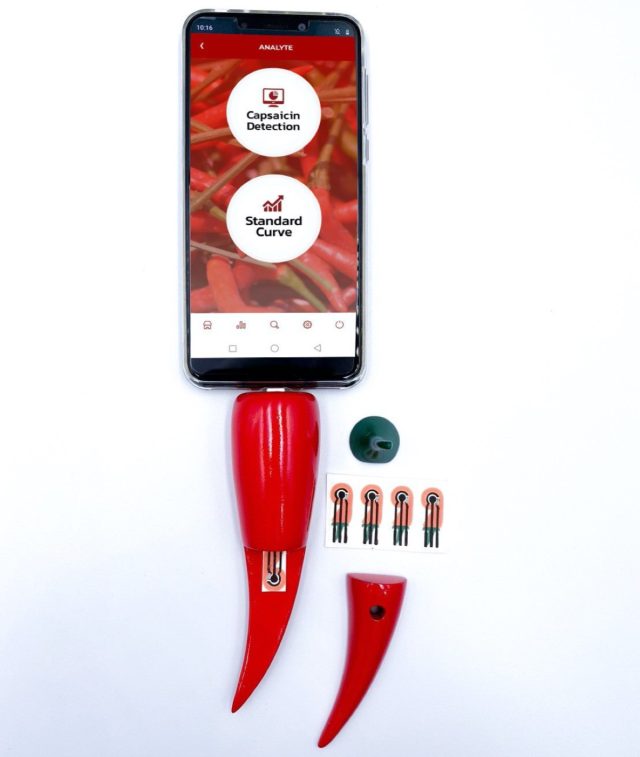
Capsaicin is the compound responsible for determining just how hot a variety of chili pepper will be; the higher the capsaicin levels, the hotter the pepper. There are several methods for quantifying just how much capsaicin is present in a pepper—its "pungency"—but they are either too time-consuming, too costly, or require special instruments, making them less than ideal for widespread use.
Now a team of scientists from Prince of Songkla University in Thailand has developed a simple, portable sensor device that can connect to a smartphone to show how much capsaicin is contained in a given chili pepper sample, according to a new paper in the journal ACS Applied Nano Materials. Bonus: the device is whimsically shaped just like a red-hot chili pepper.
An American pharmacist named Wilbur Scoville invented his eponymous Scoville scale for assessing the relative hotness of chili peppers back in 1912. That testing process involves dissolving a precise amount of dried pepper in alcohol so as to extract the capsaicinoids. The capsaicinoids are then diluted in sugar water. A panel of five trained tasters then tastes multiple samples with decreasing concentrations of capsaicinoids until at least three of them can no longer detect the heat in a given sample. The hotness of the pepper is then rated according to its Scoville heat units (SHU).
So hot right now
The Scotch bonnet and the habanero, for instance, range from 100,000 to 350,000 SHU; jalapeños fall in the range of 3,500-10,0000 SHU; and the humble bell pepper bottoms out at 0 SHU. These days there is also a plethora of so-called "super-hots" with heat ratings above 1 million SHU, such as the ghost pepper (Bhut jolokia) at 1.58 million SHU and the Naga Viper at 1.4 million SHU. In fact, there is fierce competition among chili growers in the US, UK, and Australia in particular over who can cultivate the hottest chili pepper. The hottest SHU rating to date is a US variety known as Pepper X, clocking in at a whopping 3.18 million SHU, although this has not been independently confirmed by Guinness World Records.
Here's one possible reason for the record-breaking heat of super-hots. A 2015 study used fluorescence microscopy to determine that super-hot varieties typically store as much capsaicin in the skin as in the pith, unlike conventional chili peppers, where capsaicin is stored primarily in the pith. So while experienced cooks know that removing the pith and seeds while preparing peppers also removes much of their intrinsic heat, that won't work for super-hot varieties. It's also why seasoned cooks know to handle super-hots while wearing gloves and eye protection. A single seed can burn the skin.
There's an obvious drawback to the Scoville scale method: it's pretty subjective and thus lends itself to imprecision. In fact, it has been estimated that the results from different laboratories could vary by as much as 50 percent. Different people have different numbers of mouth heat receptors, for instance, and one's palate can quickly become desensitized to capsaicinoids. That means that tasting multiple samples in a row can lead to sensory fatigue. In recent years, the emphasis has shifted to alternative methods, such as high-performance liquid chromatography, gas chromatography, colorimetry, or spectrophotometry.

"However, these methods suffer from drawbacks such as expensive instrumentation, complicated and time-consuming sample preparation, and the need for experienced operators," the authors of the new paper wrote. By contrast, "electrochemical detection methods have gained increasing research attention for capsaicin determination in chili peppers and other samples, since such methods are rapid, simple, cost-effective, sensitive, and suitable for on-site analysis."
In prior studies, researchers have developed various electrochemical methods to detect capsaicins, typically based on modified electrodes, and their results have demonstrated good accuracy, precision, and electrochemical efficiency, according to Asamee Soleh and his co-authors. But they still felt there was a need for a more affordable and portable analytical tool that was also amenable to large-scale expansion. They thought that an electrochemical paper-based analytical device (ePAD) could hold the key.
The new "Chilica-pod sensor" consists of three major components: the chili-shaped body of the device, a smartphone interface, and a detection chamber. That chamber, in turn, contains a filter and a disposable paper-based electrochemical sensor (ePAD), consisting of nitrogen-doped graphene nanoplatelets to enhance electrical conductivity. Next, the researchers dropped some diluted capsaicin onto the sensor, confirming that the resulting oxidation and reduction reactions produced an electrical current that could be detected by the ePAD.
Soleh et al. tested the device on six samples of dried chilies dissolved in an ethanol-based solution. They placed a drop in the detection chamber and found that the device could accurately measure concentrations of capsaicin in all six samples. They next compared those results to measurements obtained via spectrophotometry and found no significant difference between the two. "We hope that the fabrication and design strategy for portable sensors presented here will pave the way for new innovation in electrochemical sensors and biosensors," the authors concluded.
DOI: ACS Applied Nano Materials, 2020. 10.1021/acsanm.0c02079 (About DOIs).
reader comments
151